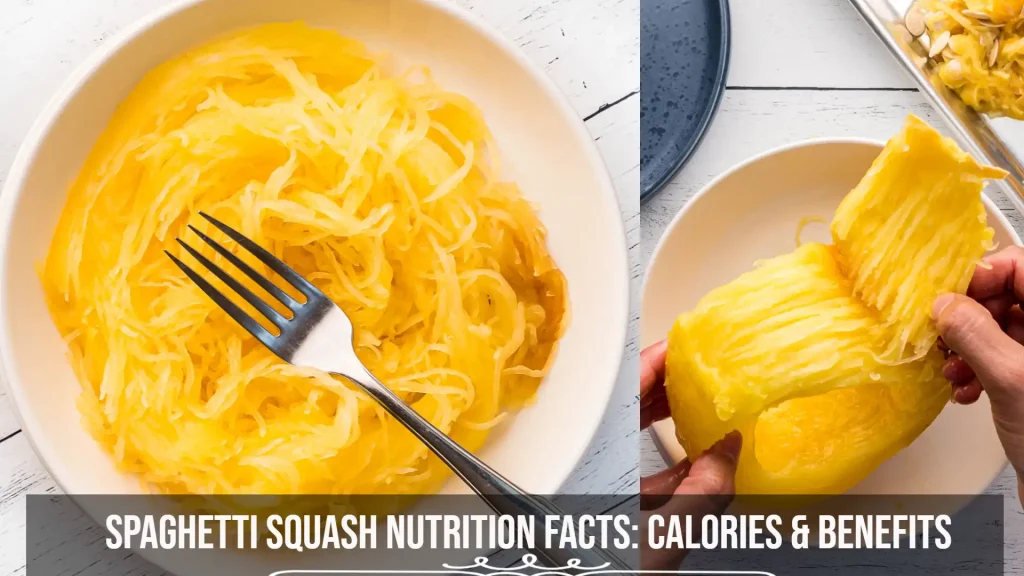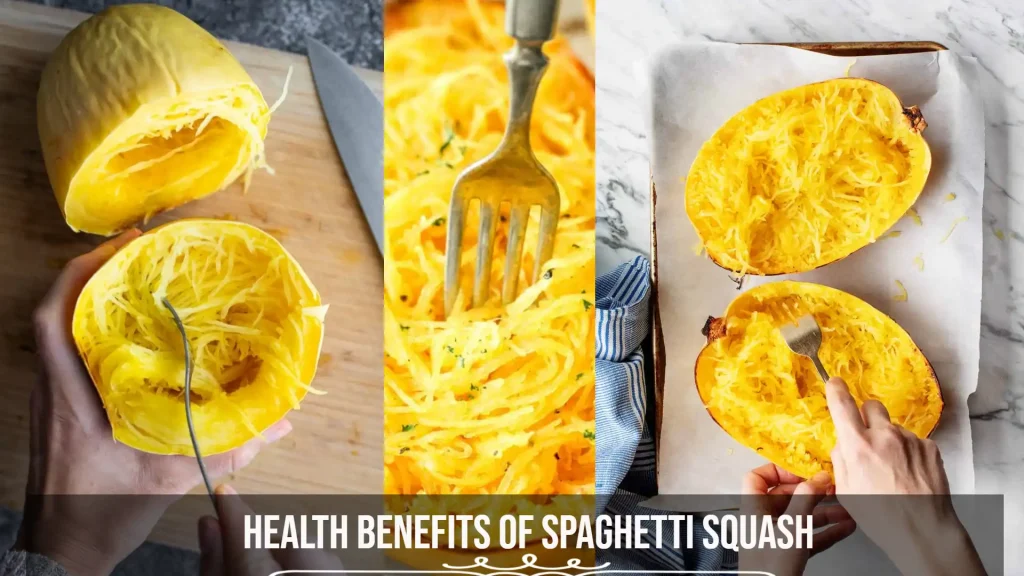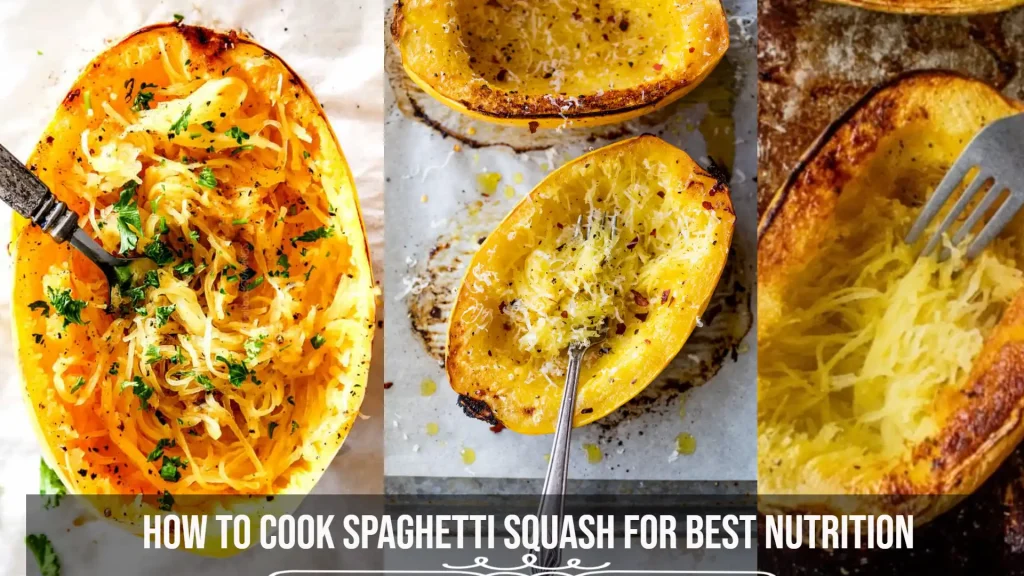If you’re looking for a healthy, low-carb substitute for pasta, spaghetti squash may be your best friend. This winter squash is light in calories, rich in nutrients, and naturally gluten-free. In this guide, we’ll break down spaghetti squash nutrition facts, calories, carbs, and health benefits — plus how to cook it perfectly.

What Is Spaghetti Squash?
Spaghetti squash (Cucurbita pepo) is a winter squash known for its unique flesh that separates into spaghetti-like strands when cooked. It typically has:
- Shape: Oblong and cylindrical
- Skin color: Pale yellow to golden
- Texture: Firm, stringy flesh resembling noodles
- Flavor: Mild, slightly sweet
You can bake, steam, or microwave it. When cooked, it’s an excellent base for sauces, stir-fries, or eaten simply with olive oil and herbs.
Spaghetti Squash Nutrition Facts (Raw, per 100g)
| Nutrient | Amount | % Daily Value |
|---|---|---|
| Calories | 27 | — |
| Total Fat | 0.3 g | 0% |
| Saturated Fat | 0.1 g | 0% |
| Cholesterol | 0 mg | 0% |
| Sodium | 18 mg | 1% |
| Potassium | 117 mg | 3% |
| Total Carbs | 6.5 g | 2% |
| Dietary Fiber | 1.4 g | 6% |
| Sugars | 2.5 g | — |
| Protein | 0.7 g | — |
| Vitamin A | 2% DV | — |
| Vitamin C | 6% DV | — |
| Calcium | 1.6% DV | — |
| Iron | 1.9% DV | — |
Key Takeaways:
- Very low in calories (only 27 kcal per 100g)
- Virtually fat-free and cholesterol-free
- Good source of fiber and Vitamin C
- Naturally gluten-free and vegan
Cooked Spaghetti Squash Nutrition Facts (per 155g serving)
| Nutrient | Amount |
|---|---|
| Calories | 42 |
| Total Fat | 0.4 g |
| Sodium | 412 mg* |
| Carbs | 10 g |
| Dietary Fiber | 2.2 g |
| Sugars | 3.9 g |
| Protein | 1 g |
| Vitamin A | 9 mcg |
| Vitamin C | 5.4 mg |
| Vitamin B6 | 0.2 mg |
| Manganese | 0.2 mg |
*Sodium varies based on how it’s cooked or seasoned.
Health Benefits of Spaghetti Squash

1. Low-Calorie, Low-Carb Pasta Alternative
Spaghetti squash has 5–7 grams of carbs per 100g, compared to about 25 grams of carbs in regular pasta. This makes it ideal for keto, diabetic, or weight-loss diets.
2. Rich in Antioxidants
Contains beta-carotene and Vitamin C, which help fight oxidative stress and boost immunity.
3. Promotes Digestive Health
With 1.4–2.2g of fiber per serving, spaghetti squash supports gut health and satiety.
4. Supports Heart Health
Potassium in spaghetti squash helps balance sodium intake and maintain healthy blood pressure.
5. Gluten-Free & Vegan-Friendly
Perfect for people with celiac disease, gluten intolerance, or plant-based diets.
Calories in Spaghetti Squash
- Raw (100g): ~27 calories
- Cooked (155g): ~42 calories
- One whole medium squash (~1,000g cooked): ~270 calories
This makes it an incredibly diet-friendly vegetable compared to wheat pasta (which can be 200 calories per cup cooked).
Carbs in Spaghetti Squash
Spaghetti squash is low in net carbs:
- Total carbs: ~6.5g per 100g
- Fiber: ~1.4g per 100g
- Net carbs: ~5g per 100g
This makes it ideal for low-carb and diabetic meal plans.
Fiber in Spaghetti Squash
Fiber aids digestion, supports gut microbiome health, and helps manage blood sugar levels. A 1-cup cooked serving offers about 2.2 grams of fiber.
Protein in Spaghetti Squash
At about 1g per cooked cup, spaghetti squash isn’t a significant protein source. Pair it with beans, tofu, chicken, or fish for a balanced meal.
Potassium in Spaghetti Squash
A 100g serving contains about 117 mg potassium, which supports heart, nerve, and muscle function.
How to Cook Spaghetti Squash for Best Nutrition

Baking Method (Most Popular):
- Preheat oven to 400°F (200°C).
- Cut squash in half lengthwise.
- Scoop out seeds.
- Brush with olive oil, season lightly.
- Roast cut-side down for 30–40 minutes.
Microwave Method (Fastest):
- Pierce squash several times.
- Microwave 10–12 minutes, turning halfway.
- Slice open, scoop out strands.
Steaming Method (Gentle Cooking):
- Keeps moisture in and retains Vitamin C.
- Steam halves or cubes for 20–25 minutes.
Spaghetti Squash vs. Pasta (Quick Comparison Table)
| Comparison | Spaghetti Squash (1 cup) | Regular Pasta (1 cup) |
|---|---|---|
| Calories | 42 | 200+ |
| Carbs | 10g | 40+ g |
| Fiber | 2g | 2g |
| Protein | 1g | 7g |
| Gluten-Free | Yes | No |
Creative Ways to Enjoy Spaghetti Squash
- Low-Carb Pad Thai: Use squash strands instead of noodles.
- Garlic Parmesan Squash Boats: Mix with cheese and bake in shells.
- Vegan “Pasta” Salad: Toss with veggies, olive oil, and lemon juice.
- Squash Stir-Fry: Sauté with tofu and tamari.
Potential Downsides
- Not a major protein source
- May become watery if overcooked
- Store properly to avoid spoilage (cool, dry place)
How to Cook Spaghetti Squash 4 Ways
FAQs About Spaghetti Squash Nutrition Facts
About 42 calories per cooked cup (155g).
Yes — only about 5g net carbs per 100g.
No — it’s naturally gluten-free.
Mainly Vitamin C, Vitamin A (beta-carotene), B vitamins, and minerals like potassium.
Yes — low calorie, low carb, and filling due to fiber.
Yes, roast them like pumpkin seeds for a crunchy snack.
3–5 days in an airtight container.
It has minimal impact compared to regular pasta due to its low-carb content.
Both are healthy, but spaghetti squash has more fiber, while zucchini is lower in carbs.
Botanically, a fruit, but culinarily used as a vegetable.
About 2.2 grams per cooked cup.
About 117 mg per 100g raw.
Yes — the fiber supports healthy digestion.
Yes, but only about 1g per cooked cup.
Yes — generally tolerated by those on a low-FODMAP diet.
References:
- USDA FoodData Central – Spaghetti Squash Nutrition
- Harvard T.H. Chan School of Public Health – Winter Squash
- Mayo Clinic – Benefits of Fiber
